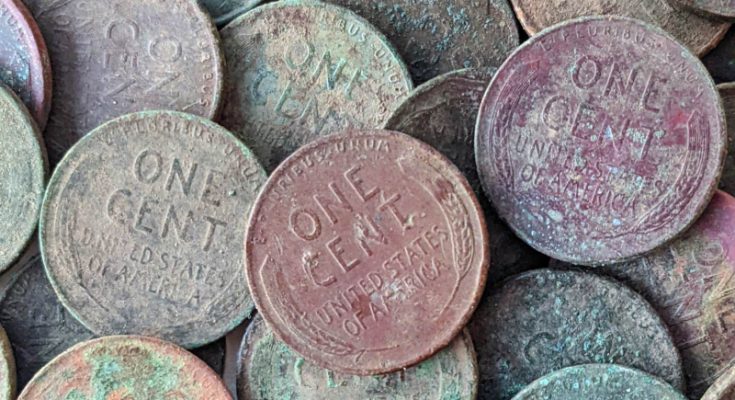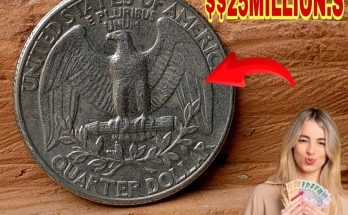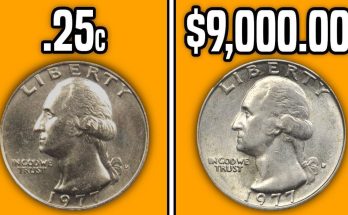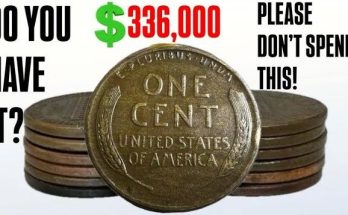Before we get into the values of these underappreciated one-cent Wheat pennies let’s get to know the history behind them. When early coins of the United States were being produced a need for the cent was necessary. In 1787 the U.S.’s first cent was created. It was larger than the modern penny and changed as the years progressed. Different artists’ versions of Lady Liberty graced the obverse of the coin and she took many forms, even being portrayed as the Indian of the infamous Indian Head penny.
The Fugio cent, also known as the Franklin cent, is the first official circulation coin of the United States. Consisting of 0.36 oz (10 g) of copper, it was designed by Benjamin Franklin and minted only in 1787.
Source Wikipedia Fugio Cent
The Indian Head cent, also known as an Indian Head penny, was a one-cent coin ($0.01) produced by the United States Bureau of the Mint from 1859 to 1909. It was designed by James Barton Longacre, the Chief Engraver at the Philadelphia Mint. By numismatic legend, the facial features of the goddess Liberty on the obverse of the Indian Head cent were based on the features of Longacre’s daughter Sarah, but this was denied and debunked.
Source Wikipedia Indian Head Cent
In 1909 to commemorate the centennial celebration of our sixteenth president Abraham Lincoln’s birth, the Lincoln Wheat cent was minted. It was the first coin the United States issued which portrayed an actual historical person on the obverse which was designed by sculptor, Victor David Brenner. Some of the first Lincoln Wheat pennies minted in 1909 contained the initials VDB to give credit to Brenner for the design. On the reverse, there are two wheat stalks surrounding the words ‘One Cent’. The Wheat penny was created and from 1909 through 1958 it carried the same design and was the inspiration for placing well-known U.S. historical figures on our currency.

Source Wikipedia Wheat Cent
Once created, the Lincoln Wheat Cent was minted in Philadelphia, Denver, and San Francisco. The mint marks can be found below the date on the obverse side accordingly. Though coins minted in Philadelphia will usually not be marked like they will with a D for Denver and S for San Francisco. Over 180,000,000 Wheat cents were minted in their fifty-year production and not all of them were created equally. Some hold more value than others and there are reasons for this.
If you’re new to coin collecting or an old pro, you’ve more than likely heard the term coin errors. Simply put, this means when the coins were being struck at the mint there were errors that occurred during production. Whether it’s due to worn down machinery or mistakes made by workers who produced the coins, errors on Wheat cents and other coins increase the value due to the rarity of the number produced. One of the most valuable mint error Wheat pennies is the 1944 steel cent which has sold for up to $400,000+ in mint state. Coin errors were never intended to be released to the public, but they were in smaller numbers than regular non-error coins.
Example of 1943 Steel Cent
Errors are not the only deciding factor for determining the most valuable Wheat cent. Four of the most sought-after Lincoln Wheat pennies without die errors are the 1909-S VDB, the 1909-S, 1931-S, and the 1944 steel cent. All four of these are worth far more than one cent. However, the more of these coins that are found and offered can increase or decrease the overall value as can their overall condition. Value can still be found in coins that are not in mint condition depending on their rarity to collectors.
Example of a Rare 1909-S VDB Lincoln Cent,
with Brenner’s initials at the base of the reverse.

How can you tell what your coin is worth? Well, do not turn to eBay as your price guide. There are reputable sellers there, but they are not the go-to source for finding the value of your Wheat cents. Sites such as PCGS and NCG which are both professional coin grading companies offer a large amount of coin information as well as current values. Coin professionals, commonly referred to as Numismatics can also be a great source of information in determining the value of your Wheat penny and other collectible coins. Price guides which are updated yearly are another great source for identifying and valuing all sorts of coins including the Wheat penny.
The Only Known Example of the 1943 Tin Cent

Another way you can find value in your Wheat pennies is to curate a collection of them from each year they were produced. Some collectors will pay a good price for an entire 1909-1958 series of Wheat cents. They are commonly sold in collector’s books which are labeled with each year and you can simply pop them into place as you collect them, replacing better examples as you go.
The majority of Lincoln Wheat pennies are worth three to four times their face value. Though that doesn’t seem like much it is still an increase in face value, but not as much as errors or the initial 1909-S VDB Wheat cent could bring in. Multiple factors determine just how much that Lincoln Wheatie is worth, but it is worth paying attention more closely to these commonly underappreciated coins. The next time you are metal detecting and come across a Wheat cent be sure to check the date and the details carefully. You may just be looking at a penny worth quite a bit of money. Happy hunting.
Most Valuable Wheat Cents 2022
| 1931 – S | $70 – $150 |
| 1917 Double Die | $100 – $5,000 |
| 1909 – S | $100 – $300 |
| 1909 – S Over Horizontal S | $120 – $350 |
| 1914 – D | $200 – $2,500 |
| 1922 – D No D | $500 – $20,000 |
| 1909 – S VDB | $700 – $1,500 |
| 1955 Double Die | $1,000 – $1,800 |
| 1944 Steel Cent | $75,000 – $125,000 |
| 1943 Bronze Cent | $100,000 – $200,000 |









